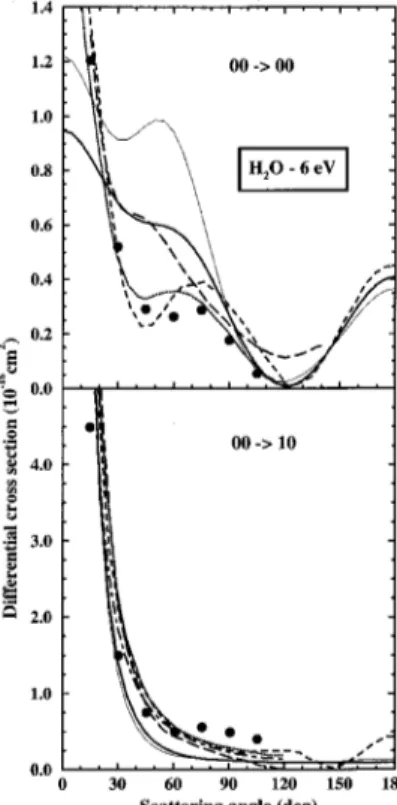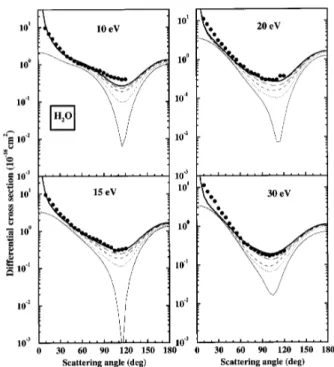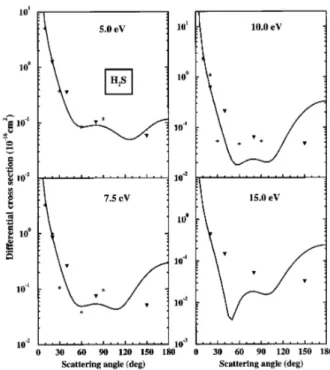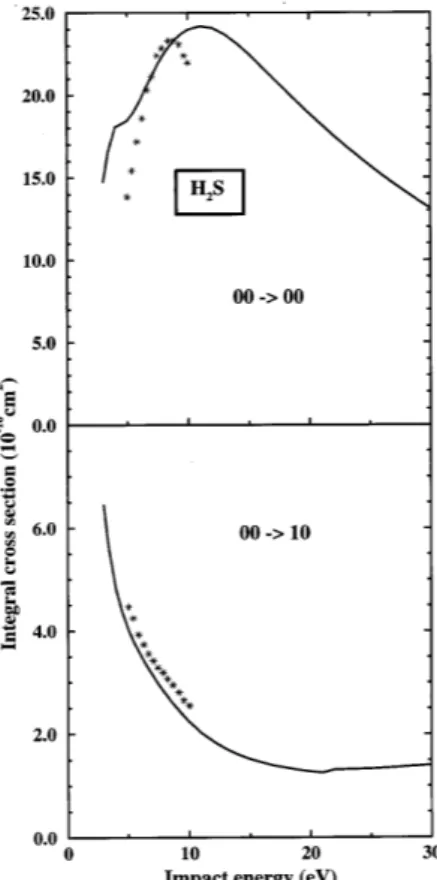Appliations of the Shwinger Multihannel Method
with Pseudopotentials to Eletron Sattering from
Polyatomi Moleules II. Rotational
Exitation Cross Setions
Mario T. do N. Varella,
InstitutodeFsiaGlebWataghin,
UniversidadeEstadual deCampinas,UNICAMP,
13083-970, Campinas,SP,Brazil
Mario H. F. Bettega,
Departamento deFsia,UniversidadeFederaldoParana,
Universidade FederaldoParana
CaixaPostal19044,81531-990, Curitiba,PR,Brazil
Alexandra P. P. Natalense,Luiz G.Ferreira, and Maro A. P. Lima
InstitutodeFsiaGlebWataghin,
UniversidadeEstadual deCampinas,UNICAMP,
13083-970, Campinas,SP,Brazil
Reeivedon14Marh,2000
Thispaperreportsresultsfor rotationalexitation ofH2OandH2Smoleulesbyeletronimpat.
It is also adatabasis inluding tables of previouslypublishedrotationally resolvedross setions
for CH4, SiH4, GeH4, SnH4, PbH4, NH3, PH3, AsH3, SbH3, CF4, CCl4, SiCl4 SiBr4, and SiI4.
Oursattering amplitudes werealulated usingtheShwingermultihannelmethodwith
norm-onservingpseudopotentialsandtherotationalresolvedrosssetionswereobtainedwiththehelp
of the adiabati nulei rotation approximation. Our results are in good agreement with other
theoretialdataandexperimentalresultswhenavailable.
All tables are available in the eletroni version of the paper only [on the world wide web at
http://www.sbf.if.usp.br/bjp/Vol31/Num1/℄.
I Introdution
It hasbeenpointedoutbydierentauthors[1, 2℄that
rotational exitation of moleular gases is a relevant
energy{lossmehanisminsloweletrondisharges.
Al-thoughtheaverageenergytransferperollisionisonly
a fration of onemeV, the order of magnitude of
ro-tational exitation rosssetions anbe10 16
m 2
or
evenlarger.Asaresult,purerotationalenergytransfer
an be quite eetive in disharge environments orin
theionosphereofEarth[2℄.
The Shwinger Multihannel Method implemented
with Pseudopotentials(SMCPP) [3℄hasbeenapplied,
along with the adiabati{nulei{rotation (ANR)
ap-setionsforsomepolyatomitargets,suh asXH
4 (X:
C, Si, Ge, Sn, Pb) [5℄, XH
3
(X: N, P, As, Sb), CF
4 ,
CCl
4 ,SiCl
4 ,SiBr
4
andSiI
4
[6℄. Inthispaper,weshow
dierential,integralandmomentumtransferrotational
exitation ross setions of H
2
O and H
2
S moleules.
We also present tables not reported in previous
pub-liations[5,6,7℄and rotationallyresolvedmomentum
transferrosssetionsforCX
4
(X:F,Cl)andSiY
4 (Y:
Cl,Br,I)notpublishedinRef. [6℄. Thispaperis
om-plementarytoRef. [8℄,whereelastisattering ofslow
eletronsby H
2
Xmoleules (X: O,S, Se, Te) was
dis-ussedandalso to theompanionpaper[9℄, where we
present elasti results for a wide range of moleules.
However, we also intend to present here a omplete
easilybeomparedtofutureexperimentsandother
al-ulations.
Someofthemoleulestreatedhereareplasma
pro-essing gases[10, 11℄ and others are also of biologial
and environmental interest [11℄. Despite their
indus-trialandenvironmentalimportane,studiesoneletron
interations with these moleules are verysare. To
ourknowledge, thisis the rstolletionof rotational
exitationrosssetionsbyeletronimpatforsomeof
themoleulesitedabove.
This paperisoutlined asfollows. In setionII,we
present abrief review of the theory and desribe the
main approximationsusedin ouralulations. In
Se-tion III, we present our results and disussion. This
setion is divided in four subsetions. In subsetion
III.a,wewillreportournewresultsforrotational
exi-tation ofwaterandsuldri aid. Insubsetions III.b
toIII.d,wewillshowresultsforrotationalexitaionof
CH 4 ,SiH 4 ,GeH 4 ,SnH 4 and PbH 4 (III.b);NH 3 , PH 3 , AsH 3 and SbH 3 (III.); CF 4 , CCl 4 , SiCl 4 , SiBr 4 and SiI 4 (III.d). II Theory
The implementation of pseudopotentials in the
Shwinger multihannel method allows alulationsof
low-energyeletronsatteringbymoleulesontaining
atomswithmanyeletronswithreduedomputational
eort [3℄. The basi idea is to replae the ore
ele-trons andthenuleusofeah atomin themoleuleby
the orresponding soft norm-onserving
pseudopoten-tialandtodesribethevaleneeletronsinaquantum
hemistry framework (Hartree-Fok approximation in
the present implementation). The ross setions for
eletron sattering by moleules with dierent atoms
butwiththesamenumberofvaleneeletronsanthen
be alulated with about the same omputational
ef-fort. Intheompanionpaper[9℄,weomparetheatual
numberofeletronsandthenumberofvaleneeletrons
foreahoneofthemoleulesstudiedhere. Forsomeof
thesemoleulesanall-eletronrosssetionalulation
would beimpratial.
The Shwinger multihannel method has been
de-sribed previously and we only review here some key
featuresforompleteness. Inthismethod,theworking
expressionforthesatteringamplitudeis
[f ~ k i ; ~ k f ℄= 1 2 X m;n hS ~ k f jVj m i(d 1 ) mn h n jVjS ~ k i i; (1) where d mn =h m jA (+) j n i (2) A (+) = ^ H
N+1 (
^
HP+P ^
H)
2
+
(VP+PV)
2 VG (+) P V: (3)
IntheaboveequationsjS
~
ki
iistheprodutofa
tar-get state and a plane wave, V is the interation
po-tential between the inident eletron and the target,
j
m
i is a (N+1)-eletron Slater determinant used in
theexpansionofthetrialsatteringwavefuntion, ^
His
thetotalenergyoftheollisionminusthefull
Hamilto-nianofthesystem,P isaprojetionoperatorontothe
open hannel spae dened by target eigenfuntions,
andG (+)
P
isthefree-partileGreen'sfuntionprojeted
ontheP-spae.
Theform of theoperator P andthe set of
(N+1)-eletron Slater determinants dene the main
approxi-mationsinoursatteringalulations. Inthiswork,we
do not onsider real eletroni exitations of the
tar-getbyeletronimpat. Theonlyopenhannelisthen
the elasti hannel and the projetion operator P is
thendened bythetargetgroundstate. Inthestati{
exhangealulationstheSlaterdeterminantsj
m iare
onstrutedas:
j
m
i=Aj
0 ij i i; (4) where j 0
i is the target ground eletroni state, j
i i
are one{partile sattering funtions and A is the
an-tissymetrizationoperator. Inour alulations, we use
themoleularvirtualorbitalstorepresentthefuntions
j
i i.
The polarization of the target due to the eletri
eldoftheinidenteletronistakenintoaountinour
methodbyinludingvirtualeletroniexitedstatesof
thetargetintheonstrutionoftheSlaterdeterminants
j
m i:
j
m
i=Aj
j ij
i
i: (5)
Inequation 5 theindex j runs overthe eletroni
states of the moleular target, beginning with the
groundstateuptosomehosenexitedstate.
We use the norm-onserving pseudopotentials of
BaheletHamannandShluter[12℄todesribethe
nu-lear potential and the ore eletrons of eah atom.
These pseudopotentialswereimplementedin theSMC
methodasdesribedinRef.[3℄. TheartesianGaussian
funtionsusedtodesribethemoleularandsattering
orbitalswereespeiallydesignedtobeusedinour
pseu-dopotentialalulations[13℄.
Ourrosssetionswereobtainedinthexed-nulei
stati-exhangeapproximation. Wedonotinlude the
desriptionofpolarizationeets,sinetheyareknown
tobeoflittleimportanefortheimpatenergyrangewe
studyhere(5{30eV).(Wepresentstati-exhangeand
The adiabati{nulei{rotation (ANR)
approxima-tion expression for the ! 0
rotational exitation
sattering amplitudeisgivenby[4℄
f( ! 0 ; k in ; ~ k out )= h 0 ()jf lab (k in ; ~ k out
;)j ()i : (6)
In the above expression, f lab
is the elasti sattering
amplitude written in the laboratory{xed frame (LF)
1 . ~ k in and ~ k out
are, respetively, inoming and
out-going wave{vetors; (;;) are the Euler
an-gles dening the frame transformation [5, 14℄; ()
are rotational eigenfuntions of the target; and
de-notes a omplete set of rotational quantum numbers.
Amongthemoleulesonsideredhere,onends
spher-ial,symmetriandasymmetri{tops. Ineahofthese
three ases, one should observe the appropriate
rota-tional quantum numbers, eigenfuntions and the
or-ret degeneraies of rotational levels. The rotational
eigenfuntions for both spherialand symmetri{tops
arewrittenas
JKM ()=
2J+1
8 2 D J KM
(); (7)
where D J
KM
are the well{known Wigner rotation
ma-tries[14℄;J isthetotalmoleularangularmomentum;
andKandM are,respetively,itsprojetionontothe
quantization axisof moleular and laboratory frames.
Rotational levels of spherial{tops present (2J+1) 2
{
fold degeneraies,relatedto K and M quantum
num-bers [5℄. For suh systems, the rotational exitation
rosssetionsaregivenby
d
d
(J !J 0 ; out )= 1 2 1
(2J+1) 2 J X K;M= J J 0 X K 0 ;M 0 = J 0 k J 0 k J Z 2 0 djf
JKM !J 0 K 0 M 0 j 2 : (8) where k J 0 andk J
areoutgoingandinomingwavevetormoduli,respetvely. Symmetri{toprotationallevels,on
the otherhand,are (2J+1){folddegenerated [7℄. Therosssetions, remindingthat degeneraiesare assoiated
onlywithM quantumnumber,arewrittenas
d
d
(JK !J 0 K 0 ; out )= 1 2 1
(2J+1) J
X
M= J J 0 X M 0 = J 0 k J 0 K 0 k JK Z 2 0 djf
JKM !J 0 K 0 M 0j 2 : (9)
Forasymmetri{tops,K isno longer agood quantum number,and the rotationaleigenfuntions, s
JM
(), are
givenbysymmetry{adaptedlinearombinationsofsymmetri{topeigenfuntions[15℄:
s JM ()= J X K=0 1 X =0 a J KM s JKM
(); (10)
where s JKM ()= 1 p 2 [ JKM
+( 1)
J KM
℄ ;K>0 ; =0;1; (11)
s
JKM ()=
JKM
;K=0: (12)
Intheexpressionsabove, isapseudoquantum numberintroduedto distinguishtheasymmetri{top
eigenfun-tions[15℄;anda J
KM
areexpansionoeients. Therotationalexitationrosssetionsaregivenby
d
d
(J !J 0 0 ; out )= 1 2 1
(2J+1) J X M= J J 0 X M 0 = J 0 k J 0 0 k J Z 2 0 djf
JM !J 0 0 M 0 j 2 : (13) d
Both symmetriandasymmetri{topspresent
per-manentdipole moments. Totakedipole{related long{
rangeinterationsintoaount,weapplyaBornlosure
proedure to the dipole{allowed rotational exitation
ross setions (J = 0K = 0 ! J 0
= 1K 0
= 0 for
symmetri{tops and J = 0 = 0 ! J 0
= 1 0
= 0
forasymmetri{tops.) Wealso takeadvantadgeofthe
rotational energy transfer to avoid divergene of
dif-ferentialrosssetions atforwardsatteringdiretion.
TheBorn{losureproedureisarefullydisussed
where[7,8℄.
III Results and Disussion
Duetothenarrowspaingbetweenneighbouring
rota-tionallevelsofpolyatomimoleules,experimentaldata
onerningrotationallyresolvedrosssetionsarevery
sare. Among the moleules addressedin this work,
weouldndrotationallyresolveddiferentialross
se-tions for H
2
O [2℄ and CH
4
[16℄. Theoretial work is
also skethy. There are reported rotational exitation
ross setions only for CH
4
[5, 17, 18℄, SiH
4
[5, 18℄,
NH
3
[7,19, 20℄,H
2
O[21, 22, 23,24℄ andH
2
S[19,25℄.
Wepresentourresultsbelow.
H
2
O and H
2 S
InFigs.1and2weshowrotationallyresolved
dier-entialrosssetions(DCS)forwaterat2.14and6.0eV.
Ineahgure,therotationally elasti(00 !00)and
dipole{allowed(00 !10)transitionsareonsidered.
For bothenergies, we present twosets of alulations
obtainedat stati{exhange(SE) and stati{exhange
plus polarization (SEP) levels of approximation. For
omparisonpurposes,wealsoshowtheoretialSEP
re-sultsofJainandThompson[21℄,Gianturo[22℄,Greer
and Thompson [23℄ (6.0 eV only) and Gianturo et
al.[24℄ (00 !10rotational exitationonly).
Experi-mental dataofJunget al.[2℄isalso shown. OurDCS
fortherotationallyelastiexitationat2.14eVpresent
a maximum between 50 o
and 90 o
not notied either
in the experimental data [2℄ or in the other
alula-tions[21,22℄,althoughourSEPresultagreesverywell
withmeasurementat15 o
and30 o
. At6.0 eV,our
al-ulationsshowabetteragreementin shapewithother
results, but onestillobservesdisrepany around60 o
.
Itistobepointedoutthatourelasti(rotationally
un-resolved)DCSshoweddisagreementwithexperimental
dataandpreviousalulationsatinidentenergies
be-low 8.0eV, around60 o
[8℄. Itis notsurprising,
there-fore, that rotationally resolved ross setions present
a similar behavior. All alulations and experimental
DCSagreebetterforthe00 !10exitation,whihis
mainlydeterminedbydipolemomentinterations. Itis
interestingtoobservethatourresultsat2.14eVarein
betteragreementwith experimental data, lying below
the other alulations. This was also to be expeted,
sineourBorn{orretedrotationallysummedintegral
rosssetion(ICS)showedbetteragreementwith
mea-Figure 1. Rotationally resolved dierential ross setions
for e {H2O sattering at 2.14 eV. Upperpart:
rotation-ally elasti (00 ! 00) exitation. Lower part: dipole{
allowed(00 !10) exitation. Thik solid lines: present
results (SEP approximation); thin solid lines: present
re-sults (SEapproximation); dotted lines: Jain and
Thomp-son[21 ℄;long{dashedlines: Gianturo[22 ℄;dot{dashedline:
Gianturoetal.[24 ℄(00 !10exitationonly);bullets:
ex-perimentaldataofJungetal.[2℄.
Figure 3. Rotationally resolved dierential ross setions
fore {H
2
Osatteringat30eVforJ=0 !J 0
=0;1;2;3
exitations (summedover 0
). Solid lines: present results
(SEapproximation);stars: Gianturoetal.[24℄.
InFig.3,we ompareourSErotationallyresolved
DCS forH
2
OwithalulationsofGianturoetal.[24℄
forJ =0 !J 0
=0;1;2;3exitations,whereross
se-tionswith sameJ 0
weresummed over 0
. Onenoties
goodagreementinmagnitudeandverygoodagreement
in shape for all rotational transitions, reeting the
observedgood agreementof elasti(rotationally
unre-solved)DCS [8℄at 30eV.
Inorder toilustrate theonvergeneof presentSE
alulationsforwater,wepresentinFig.4,andalsoin
TablesIandII,rotationallysummedDCS(RSDCS)at
10,1520,and30eV.Foreahenergy,weshowRSDCS
summed fromJ =0uptoJ 0
=0;1;2;3;4and7. (For
agiven J 0
,wesumover 0
.) Wealso showelasti
(ro-tationallyunresolved)experimentalDCS of Johnstone
andNewell[26℄. Itislearthatonvergeneisahieved
forJ 0
=4,beausethedot{dashedlines,orresponding
to RSDCSupto J 0
=4,are oftenhiddenbythe solid
thikline(RSDCSuptoJ 0
=7). Oneanalsoobserve
signiant ontributions of rotationally inelasti
exi-tationsto RSDCSaround120 o
,where therotationally
elastiDCSpresentminima,andneartheforward
sat-Figure4.Rotationallysummeddierentialrosssetionsfor
e {H
2
Osatteringat10, 15,20and30eV,fromJ=0up
todierentJ 0
. (ForagivenJ 0
,rosssetionsweresummed
over 0
.) Thin solid lines: J 0
= 0; dotted lines: J 0
= 1;
short{dashedlines: J 0
=2;long{dashedlines: J 0
=4;thik
solidlines: J 0
= 7 [8 ℄; bullets: elasti (rotationally
unre-solved)experimentalDCSofJohnstoneandNewell[26 ℄.
InFig.5weshowSErotationally resolvedintegral
rosssetion(RSICS)forwater,alongwithalulations
of Gianturo et al. [24℄. J =0 ! J 0
=0;1;2;3
ex-itationsareonsidered,and weagainsumover 0
for
eahJ 0
. Ingeneral,thereisverygood agreementboth
in shape and magnitude, although some disrepany
isfound forthe dipole{allowedexitation (at all
ener-gies)andalso at6.0eVfor0 !0;2transitions. This
behaviorwastobeexpeted, onsideringtheobserved
behavior of elasti(rotationally unresolved) ross
se-tions[8℄(seealsodisussionofFigs.1and2.)
Next, we show SE rotationally resolved DCS for
H
2
S. We adress 00 ! 00 (Fig. 6) and 00 ! 10
(Fig. 7) exitations at 5, 7.5, 10, and 15 eV.
Calu-lations ofGianturo[19℄ (00 !10only) andof Jain
and Thompson [25℄ are also presented for omparison
purposes. One nds,in general, good agreementboth
in shape andmagnitude. Some disagreementis found
at10and15eVforthe00 !10exitation,though. It
istobeobservedthatourrotationallysummedintegral
rosssetion(ICS)forH
2
Sagreeswellwith
experimen-taldata[8℄.
RotationallyresolvedICS for00 !00and00 !
10exitationsareshowninFig.8(SEapproximation),
along with results of Jain and Thompson [25℄. One
ex-tationallyelastiICS.Ourresultspresentaverybroad
maximumaround10 eV,while alulationofRef. [25℄
showanarrowermaximum8eV.
Figure 5. Rotationally resolved integral ross setions for
e {H
2
Osattering. (Allresultsaresummedover 0
.)
Up-per part: Thik solid line: 0 ! 0 exitation (present
SE result);bullets withthinsolidline: 0 !0 exitation
(Gianturoet al.[24 ℄);thik long{dashedline: 0 !1
ex-itation(presentSEresult);squareswiththinlong{dashed
line: 0 !1exitation(Gianturoetal.[24 ℄). Lowerpart:
Thiksolidline: 0 !2exitation(presentSEresult);
dia-mondswiththinsolidline: 0 !2exitation(Gianturoet
al.[24℄);thiklong{dashedline: 0 !3exitation(present
SE result); triangles with thinlong{dashed line: 0 ! 3
exitation(Gianturoetal.[24℄).
ConvergeneofpresentSEalulationsforsuldri
aid is illustrated in Fig. 9. We show rotationally
summed DCS (RSDCS) at 10, 15, 20, and 30 eV.For
eahenergy, weshowRSDCS summedfrom J =0up
toJ 0
=0;1;2;3;4and7. (ForagivenJ 0
,wesumover
0
.) (Seealso TablesIII andIV.) Wealsoshowelasti
(rotationally unresolved) experimental DCS of Gulley
et al. [27℄. It islear that onvergene isahievedfor
J 0
=4,beausethedot{dashedlines,orrespondingto
RSDCS up to J 0
= 4, are often hidden by the solid
thik line (RSDCS up to J 0
= 7). One an also
ob-serve signiant ontributions of rotationally inelasti
o
allyelastiDCS presentminima,andneartheforward
sattering diretion (due to the dipole{allowed
transi-tion).
Figure6. Rotationallyelasti(00 !00) dierentialross
setions for e {H
2
S at 5.0, 7.5, 10.0 and 15.0 eV. Solid
lines: present results (SEapproximation); stars: Jain and
Thompson[25 ℄.
Figure 7. Rotationally resolved dierential ross setions
fore {H2Sforthedipole{allowed(00 !10)exitationat
5.0, 7.5, 10.0 and 15.0 eV. Solidlines: present results (SE
Figure 8. Rotationally resolved integral ross setions for
e {H2S sattering. Upper part: 00 ! 00 exitation.
Lowerpart: 00 !10exitation. Solid lines: presentSE
result;stars: JainandThompson[25 ℄.
Figure9.Rotationallysummeddierentialrosssetionsfor
e {H2Ssattering at10,15, 20and30eV,fromJ=0up
todierentJ 0
. (ForagivenJ 0
,rosssetionsweresummed
over 0
.) Thin solid lines: J 0
= 0; dotted lines: J 0
= 1;
short{dashedlines:J 0
=2;long{dashedlines:J 0
=4;thik
solid lines: J 0
= 7 [8℄; bullets: elasti (rotationally
unre-Figure 10. Integral ross setion (ICS) for water (upper
part)andsuldriaid (lowerpart). Solid lines:
rotation-allysummedICS(J 0
=0up toJ 0
=7);long{dashedlines:
ICSfor00 !00exitation;dottedlines:ICSfor00 !10
exitation;dot{dashedlines: rotationallysummedinelasti
ICS(J 0
=1uptoJ 0
=7).
Finally, in Fig.10 we showICS forbothH
2 O and
H
2
S. Foreah moleule, wepresentICS for00 !00
and00 !10rotationalexitations;inelasti
rotation-allysummed(IRS) integralross setion,from J 0
=1
up to J 0
= 7; and also rotationally summed ICS
(RSICS), from J 0
= 0 up to J 0
= 7. (Integral and
momentumtransferrotationallyresolvedrosssetions
arealso shown in TablesV andVI, respetively.) For
watermoleule,itislearthatthedipole{allowed
tran-sitionprovidesthemostsigniantontributiontoIRS
integralross setion, being even greater than the
ro-tationallyelastiexitation,forinidentenergiesbelow
10 eV. The less polar H
2
S moleule presents smaller
ICS for the dipole{allowed rotational exitation, and,
asaresult,itsIRSintegralrosssetionisonsiderably
smallerthantherotationallyelastiICS.Itis
interest-ingtoobservethat IRSintegralrosssetionforwater
isalmost ashigh asthe elasti(rotationally summed)
ICS,forE<7:5eV.Asaresult,oneshouldexpet
rota-tionalexitationstobeanimportantenergy{loss
ontain-XH
4
(X = C, Si, Ge, Pb, Sn)
TablesVIItoXIpresentourpreviouslypublished[5℄
dierentialrosssetionsforrotationalexitationofthe
XH
4
(X = C, Si, Ge, Pb, Sn) moleules at seleted
energies. Ourresults were foundto be in good
agree-ment with previous alulations for CH
4
[17, 18℄ and
SiH
4
[18℄. Our results for methane also showed good
agreement with experimental data [16℄. Ref. [5℄ also
shows tableswith ourintegralross setionsand with
ourmomentumtransferrosssetions.
XH
3
(X = N, P, As, Sb)
TablesXIItoXIVpresentourdierentialross
se-tionsfrom Ref.[7℄at 10eV, 20eV,and30 eV
respe-tively. Thereare othertheoretialelasti(rotationally
unresolved)resultsintheliteratureforNH
3 ,PH
3 ,and
AsH
3
[19, 20, 28℄ and experimental datafor NH
3 and
PH
3
[29℄, allin good agreement withour rotationally
summedrosssetions. Ourrotationallyresolvedross
setions for NH
3
were found to bein good agreement
withpreviousalulations[19,20℄(seeRef.[7℄). Tables
with ourintegralross setionsand with our
momen-tumtransferrosssetionsareshowninRef.[7℄.
CF
4 , CCl
4 , SiCl
4
, SiBr
4
, and SiI
4
Our rotational momentum transfer ross setions
are shown in Table XV. Tables with rotational
inte-gral ross setions are shown in Ref. [6℄. Due to the
largeperipheralatoms, these moleules were found to
have large rotationally inelasti ross setions (being
omparable in magnitude with respetive rotationally
elastirosssetions). Adetaileddisussionisfoundin
Ref.[6℄.
Tables
All tables are available only in the eletroni
version of the paper on the world wide web at
http://www.sbf.if.usp.br/bjp/Vol31/Num1/.
Aknowledgments
A.P.P.N.aknowledgessupportfromFunda~aode
AmparoaPesquisadoEstadodeS~aoPaulo(FAPESP).
M.H.F.B.,L.G.F.andM.A.P.L.aknowledge
par-tial support from Brazilian agenyConselho Naional
de Desenvolvimento Ciento e Tenologio (CNPq).
M. T. N. V. aknoledges both FAPESP and CNPq.
OuralulationswereperformedatCENAPAD-SP,at
CENAPAD-NEandat CCE-UFPR.
Referenes
[1℄ N.F.Lane,Rev.Mod.Phys.52,29(1980).
[2℄ K.Jung,Th.Antoni,RMuller,K.H.KohemandH.
[3℄ M. H.F.Bettega, L.G.Ferreira,and M.A.P.Lima,
Phys.Rev.A47,1111 (1993).
[4℄ D.M.Chase,Phys.Rev.A104,838(1956);A.Temkin
andK.V.Vasavada,Phys.Rev.160,190(1967);F.A.
GianturoandA.Jain,Phys.Rep.143,347(1986).
[5℄ M. T.doN.Varella,M. H.F.Bettega, and M. A.P.
Lima,Z.Phys.D39,59(1997).
[6℄ M.T.doN.Varella,A.P.P.Natalense,M.H.F.
Bet-tega, and M. A. P.Lima, Phys.Rev.A, aepted for
publiation(1999).
[7℄ M. T. do N. Varella, M. H. F. Bettega, A. J. R. da
Silva, and M. A.P.Lima, J.Chem. Phys.110, 2452
(1999).
[8℄ M.T.doN.Varella,M.H.F.Bettega,M.A.P.Lima,
andL. G.Ferreira,J.Chem.Phys.,aeptedfor
pub-liation(1999).
[9℄ A.P.P.Natalense,M.T.doN.Varella,M.H.F.
Bet-tega,L.G.FerreiraandM.A.P.Lima,submittedfor
publiationinBraz.J.Phys.(1999).
[10℄ M. Hayashi \Swarm Studies and Inelasti
Eletron-Moleule Collisions",editedbyL.C.Pithford,B.V.
MKoy,A.Chutjian,andS.Trajmar,NewYork,p.167
(1987).
[11℄ See, for example, L. G.Christophorou,J. K.Oltho,
and M. V. V.S.Rao, J.Phys.Chem. Ref.Data, 25,
1341(1996);L.G.Christophorou,J.K.Oltho,andM.
V.V.S.Rao,J.Phys.Chem.Ref.Data,26,1(1997);
L. G. Christophorou,J. K. Oltho, and Y. Wang, J.
Phys.Chem.Ref.Data,26,1205 (1997).
[12℄ G.B.Bahelet,D.R.Hamann,andM.Shluter,Phys.
Rev.B26,4199(1982).
[13℄ M. H.F.Bettega,A. P.P.Natalense, M.A.P.Lima,
and L. G.Ferreira, Int. J. QuantumChem., 60, 821
(1996).
[14℄ M. E.Rose, \ElementaryTheoryof Angular
Momen-tum",Wiley,NewYork,(1957).
[15℄ C.VanWinter,PhysiaXX,274(1954);A. Jainand
D. G. Thompson, Comput. Phys. Commun. 30, 301
(1983).
[16℄ R. Muller, K.Jung, K-H.Kohem, W. Sohn,and H.
Ehrhardt,J.Phys.B:AtMolPhys18,3971(1985).
[17℄ A. Jain, and D. G. Thompson, J. Phys. B 16, 3077
(1983); N.Abusalbi, R.A.Eades, T.Nam,D.
Thiru-malai,D.A.Dixon,D.G.Truhlar,andM.Dupuis,J.
Chem.Phys.78,1213 (1983);F.A.Gianturo, Phys.
Sri. T 23, 141 (1988); L. M. Bresansin, M. A. P.
Lima, and V. MKoy Phys.Rev. A 40, 5577 (1989);
F.A.Gianturo, J.A.Rodriguez-Ruiz,andN. Sanna
Phys.Rev.A52,1257 (1995).
[18℄ A.Jain,Z.Phys.D21,153(1991)
[19℄ F.A.Gianturo,J.Phys.B24,4627(1991).
[20℄ A.JainandD.G.Thompson,Phys.Rev.A,16,2593
(1983).
[21℄ A. Jain and D. G. Thompson, J. Phys. B 16, 3077
[23℄ R.GreerandD.Thompson,J.Phys.B27,3533(1994).
[24℄ F.A.Gianturo,S.Meloni,P.Paioletti,R.R.Luhese
ansN.Sanna,J.Chem.Phys.108,40021998.
[25℄ A.JainandD.G.Thompson17,443(1983).
[26℄ W. M. Johnstone and W. R. Newell, J. Phys. B 24,
3633 (1991).
[27℄ R. J. Gulley, M. J. Brunger and S. J. Bukman, J.
Phys.26,2813(1992).
[28℄ H.P.Prithard,M.A. P.Lima,andV.MKoyPhys.
Rev.A39,2392 (1989);T.N.Resigno,B.H.
Lengs-eld,C.W.MCurdy,andS.D.Parker,Phys.Rev.A
45,7800 (1992); C. Winstead, Q.Sun,V. MKoy, J.
L.daS.Lino,andM. A.P.Lima,Z.Phys.D24,141
(1992); J.M. Yuan, and Z.J. Zhang, Z.Phys.D28,
207(1993).
[29℄ T.W.Shyn(privateommuniation);D.T.Alle,R.J.
Gulley,S.J.Bukman,andM.J.Brunger,J.Phys.B
25,1533(1992);M.BenArfa,andM.Tron,J.Chim.



